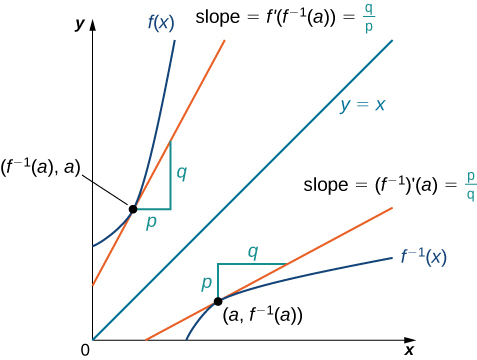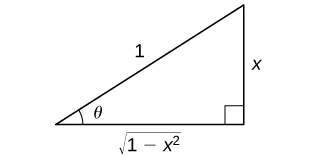Section 3.7 Derivatives of Inverse Functions
Learning Objectives.
Calculate the derivative of an inverse function.
Recognize the derivatives of the standard inverse trigonometric functions.
In this section we explore the relationship between the derivative of a function and the derivative of its inverse. For functions whose derivatives we already know, we can use this relationship to find derivatives of inverses without having to use the limit definition of the derivative. In particular, we will apply the formula for derivatives of inverse functions to trigonometric functions. This formula may also be used to extend the power rule to rational exponents.
Subsection 3.7.1 The Derivative of an Inverse Function
We begin by considering a function and its inverse. If \(f(x)\) is both invertible and differentiable, it seems reasonable that the inverse of \(f(x)\) is also differentiable. Figure 3.118 shows the relationship between a function \(f(x)\) and its inverse \(f^{-1}(x).\) Look at the point \((a,f^{-1}(a))\) on the graph of \(f^{-1}(x)\) having a tangent line with a slope of \({f^{-1}}'(a)=\frac{p}{q}.\) This point corresponds to a point \((f^{-1}(a),a)\) on the graph of \(f(x)\) having a tangent line with a slope of \(f'(f^{-1}(a))=\frac{q}{p}.\) Thus, if \(f^{-1}(x)\) is differentiable at \(a,\) then it must be the case that

We may also derive the formula for the derivative of the inverse by first recalling that \(x=f(f^{-1}(x)).\) Then by differentiating both sides of this equation (using the chain rule on the right), we obtain
Solving for \({f^{-1}}'(x),\) we obtain
We summarize this result in the following theorem.
Theorem 3.119. Inverse Function Theorem.
Let \(f(x)\) be a function that is both invertible and differentiable. Let \(y=f^{-1}(x)\) be the inverse of \(f(x).\) For all \(x\) satisfying \(f'(f^{-1}(x))\neq 0,\)
Alternatively, if \(y=g(x)\) is the inverse of \(f(x),\) then
Example 3.120. Applying the Inverse Function Theorem.
Use the inverse function theorem to find the derivative of \(g(x)=\frac{x+2}{x}.\) Compare the resulting derivative to that obtained by differentiating the function directly.
The inverse of \(g(x)=\frac{x+2}{x}\) is \(f(x)=\frac{2}{x−1}.\) Since \(g'(x)=\frac{1}{f'(g(x))},\) begin by finding \(f'(x).\) Thus,
Finally,
We can verify that this is the correct derivative by applying the quotient rule to \(g(x)\) to obtain
Checkpoint 3.121.
Use the inverse function theorem to find the derivative of \(g(x)=\frac{1}{x+2}.\) Compare the result obtained by differentiating \(g(x)\) directly.
Example 3.122. Applying the Inverse Function Theorem.
Use the inverse function theorem to find the derivative of \(g(x)=\sqrt[3]{x}.\)
The function \(g(x)=\sqrt[3]{x}\) is the inverse of the function \(f(x)=x^3.\) Since \(g'(x)=\frac{1}{f'(g(x))},\) begin by finding \(f'(x).\) Thus,
Finally,
Checkpoint 3.123.
Find the derivative of \(g(x)=\sqrt[5]{x}\) by applying the inverse function theorem.
From the previous example, we see that we can use the inverse function theorem to extend the power rule to exponents of the form \(\frac{1}{n},\) where \(n\) is a positive integer. This extension will ultimately allow us to differentiate \(x^q,\) where \(q\) is any rational number.
Theorem 3.124. Extending the Power Rule to Rational Exponents.
The power rule may be extended to rational exponents. That is, if \(n\) is a positive integer, then
Also, if \(n\) is a positive integer and \(m\) is an arbitrary integer, then
Proof.
The function \(g(x)=x^{1/n}\) is the inverse of the function \(f(x)=x^n.\) Since \(g'(x)=\frac{1}{f'(g(x))},\) begin by finding \(f'(x).\) Thus,
Finally,
To differentiate \(x^{m/n}\) we must rewrite it as \((x^{1/n})^m\) and apply the chain rule. Thus,
Example 3.125. Applying the Power Rule to a Rational Power.
Find the equation of the line tangent to the graph of \(y=x^{2/3}\) at \(x=8.\)
First find \(\frac{dy}{dx}\) and evaluate it at \(x=8.\) Since
the slope of the tangent line to the graph at \(x=8\) is \(\frac{1}{3}.\)
Substituting \(x=8\) into the original function, we obtain \(y=4.\) Thus, the tangent line passes through the point \((8,4).\) Substituting into the point-slope formula for a line, we obtain the tangent line
Checkpoint 3.126.
Find the derivative of \(s(t)=\sqrt{2t+1}.\)
Subsection 3.7.2 Derivatives of Inverse Trigonometric Functions
We now turn our attention to finding derivatives of inverse trigonometric functions. These derivatives will prove invaluable in the study of integration later in this text. The derivatives of inverse trigonometric functions are quite surprising in that their derivatives are actually algebraic functions. Previously, derivatives of algebraic functions have proven to be algebraic functions and derivatives of trigonometric functions have been shown to be trigonometric functions. Here, for the first time, we see that the derivative of a function need not be of the same type as the original function.
Example 3.127. Applying the Power Rule to a Rational Power.
Use the inverse function theorem to find the derivative of \(g(x)=\sin^{−1}x.\)
Since for \(x\) in the interval \([−\frac{\pi}{2},\frac{\pi}{2}],f(x)=\sin x\) is the inverse of \(g(x)=\sin^{−1}x,\) begin by finding \(f'(x).\) Since
we see that
Note 3.128. Analysis.
To see that \(\cos (\sin^{-1}x)=\sqrt{1−x^2},\) consider the following argument. Set \(\sin^{-1}x=\theta .\) In this case, \(\sin \theta =x\) where \(−\frac{\pi}{2}≤\theta ≤\frac{\pi}{2}.\) We begin by considering the case where \(0\lt \theta \lt \frac{\pi}{2}.\) Since \(\theta \) is an acute angle, we may construct a right triangle having acute angle \(\theta ,\) a hypotenuse of length \(1\) and the side opposite angle \(\theta \) having length \(x.\) From the Pythagorean theorem, the side adjacent to angle \(\theta \) has length \(\sqrt{1−x^2}.\) This triangle is shown in Figure 3.129. Using the triangle, we see that \(\cos (\sin^{-1}x)=\cos \theta =\sqrt{1−x^2}.\)

In the case where \(−\frac{\pi}{2}\lt \theta \lt 0,\) we make the observation that \(0\lt -\theta \lt \frac{\pi}{2}\) and hence
Now if \(\theta =\frac{\pi}{2}\) or \(\theta =−\frac{\pi}{2},x=1\) or \(x=−1,\) and since in either case \(\cos \theta =0\) and \(\sqrt{1−x^2}=0,\) we have
Consequently, in all cases, \(\cos (\sin^{-1}x)=\sqrt{1−x^2}.\)
Example 3.130. Applying the Chain Rule to the Inverse Sine Function.
Apply the chain rule to the formula derived in Example 3.122 to find the derivative of \(h(x)=\sin^{-1}(g(x))\) and use this result to find the derivative of \(h(x)=\sin^{-1}(2x^3).\)
Applying the chain rule to \(h(x)=\sin^{-1}(g(x)),\) we have
Now let \(g(x)=2x^3,\) so \(g'(x)=6x^2.\) Substituting into the previous result, we obtain
Checkpoint 3.131.
Use the inverse function theorem to find the derivative of \(g(x)=\tan^{-1}x.\)
The inverse of \(g(x)\) is \(f(x)=\tan x.\) Use Example 3.122 as a guide.
\(g'(x)=\frac{1}{1+x^2}\)
The derivatives of the remaining inverse trigonometric functions may also be found by using the inverse function theorem. These formulas are provided in the following theorem.
Theorem 3.132. Derivatives of Inverse Trigonometric Functions.
Example 3.133. Applying Differentiation Formulas to an Inverse Tangent Function.
Find the derivative of \(f(x)=\tan^{-1}(x^2).\)
Example 3.134. Applying Differentiation Formulas to an Inverse Sine Function.
Find the derivative of \(h(x)=x^2\sin^{-1}x.\)
By applying the product rule, we have
Checkpoint 3.135.
Find the derivative of \(h(x)=\cos^{-1}(3x−1).\)
Example 3.136. Applying the Inverse Tangent Function.
The position of a particle at time \(t\) is given by \(s(t)=\tan^{-1}(\frac{1}{t})\) for \(t≥\frac{1}{2}.\) Find the velocity of the particle at time \(t=1.\)
Begin by differentiating \(s(t)\) in order to find \(v(t).\) Thus,
Simplifying, we have
Thus, \(v(1)=−\frac{1}{2}.\)
Checkpoint 3.137.
Find the equation of the line tangent to the graph of \(f(x)=\sin^{-1}x\) at \(x=0.\)
Subsection 3.7.3 Key Concepts
The inverse function theorem allows us to compute derivatives of inverse functions without using the limit definition of the derivative.
We can use the inverse function theorem to develop differentiation formulas for the inverse trigonometric functions.
Subsection 3.7.4 Key Equations
Inverse function theorem \({f^{-1}}'(x)=\frac{1}{f'(f^{-1}(x))}\) whenever \(f'(f^{-1}(x))\neq 0\) and \(f(x)\) is differentiable.
Power rule with rational exponents \(\frac{d}{dx}(x^{m/n})=\frac{m}{n}x^{(m/n)−1}.\)
Derivative of inverse sine function \(\frac{d}{dx} \sin^{-1}x=\frac{1}{\sqrt{1−x^2}}\)
Derivative of inverse cosine function \(\frac{d}{dx} \cos^{-1}x=\frac{−1}{\sqrt{1−x^2}}\)
Derivative of inverse tangent function \(\frac{d}{dx} \tan^{-1}x=\frac{1}{1+x^2}\)
Derivative of inverse cotangent function \(\frac{d}{dx} \cot^{-1}x=\frac{−1}{1+x^2}\)
Derivative of inverse secant function \(\frac{d}{dx} \sec^{-1}x=\frac{1}{|x|\sqrt{x^2−1}}\)
Derivative of inverse cosecant function \(\frac{d}{dx} \csc^{-1}x=\frac{−1}{|x|\sqrt{x^2−1}}\)
This book is a custom edition based on OpenStax Calculus Volume 1. You can download the original for free at https://openstax.org/details/books/calculus-volume-1.